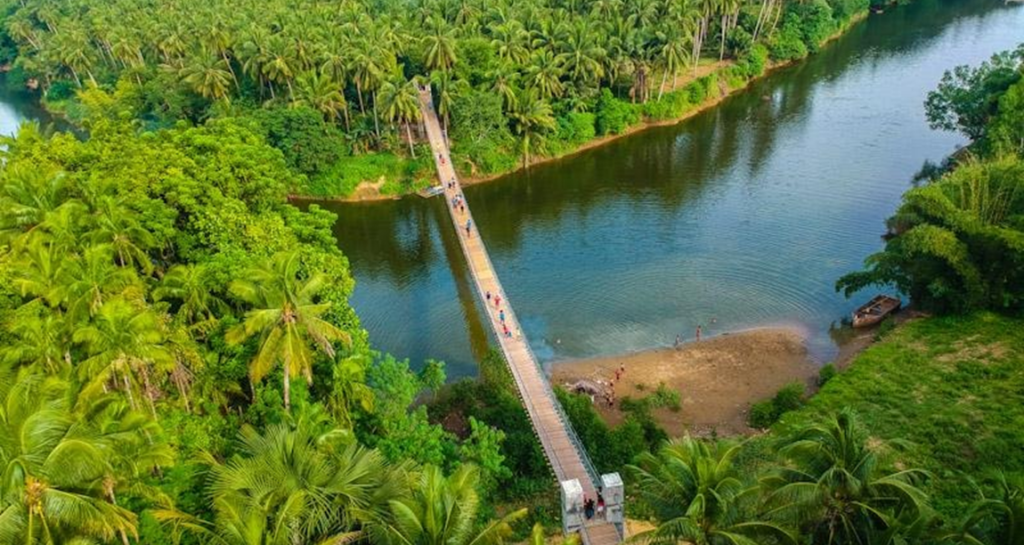What’s in a name? There’s a lot to it. By itself, a town’s name holds secrets of its past. It speaks of the place – the characteristics of the land and its inhabitants.
It may be observed that the original settlements have names derived from indigenous words. These include Baclayon, Dauis, Jagna, and Talibon to name a few.
When the Spaniards came, they found some villages already existing. The usual story goes of the foreigner asking the name of the place, “Como te llama este sitio?” Not understanding Spanish, the Boholano usually speculates and blurts out an answer to what he or she thought was being asked of, to which the stranger takes as the name of the place. From this category comes the town of Loboc, Dimiao, Bilar, Candijay and Maribojoc.
Later, under the Spanish colonial era; it came naturally that municipalities were named after towns and cities of Spain, such as Valencia, Sevilla, Corella, Jetafe. Some take after the name of their patron saints like Pilar, Carmen, and San Isidro. Others are derived from simple Spanish words as Buenavista, Bien Unido, Cortes, and Sierra Bullones.
Towns created post-Spanish colonial period were renamed after prominent Boholanos like Sikatuna, Dagohoy, Pres. Carlos P. Garcia, and Bohol Governor Clarin. Others are after national figures, like Mabini, and do you know that two towns are named after the wives of the Philippine presidents who signed the executive order creating the municipality?
Read on and discover.
Tagbilaran City. There are two theories how TAGBILARAN got its name. First is from the word Tinabilan, which means hidden by a cloth or curtain, with Panglao Island as the curtain which shields the city from strong southwestern monsoons. Second is from two words tagu which means “to hide” and Bilaan which is the name of a tribe from Southern Philippines, said to be raiding the natives then. It may be recalled that Tagbilaran was chosen as capital of Bohol in 1854 by Spanish Gov. Gen Marquez de Novaliches due to its location which is easily defensible from the Moro pirates.
Baclayon – derived from the word, “bacay,” which means detour as early travelers coming from Tagbilaran used to detour around the rocky cliffs in going to this town.
Balilihan – comes from the abundance of “balili” a kind of grass endemic to the area.
Batuan – is the name of the edible plant that used to grow luxuriant in the interior town.
Catigbi-an – is derived from “katigbi,” a kind of plant native to the place.
Loay – comes from “oway” plant which grew plenty in the ancient village.
Lila – is named after lilac; those violet colored water lilies in a big lake located in the town.
Dauis – is from the word “dawi,” which in fishing parlance means a fish biting the bait of a fishing hook and line.
Panglao – is derived from the word “panggao,” a fish-catching device made of rattan and bamboo.
Guindulman – comes from the word gui-duhman. Travelling from Tagbilaran to Ubay, one could feel “benighted” in reaching the place being densely forested with swamp lands and foliage.
Sagbayan. This town used to be inhabited by monkeys, deer, and wild pigs and people who came to hunt hang the hides of their catch unto branches of trees there. Hence, it was called “sagbayan,” meaning a place for hanging hides.
Loon – from the root word “tubig-loon” meaning existing side by side.
Inabanga – derived its name from the river there. Every year, it was said that human lives are lost either by drowning or by an attack of crocodiles, which made the inhabitants believe that such must be the abang or the rental for the use of the river.
Jagna – comes from the legendary expression by the inhabitants “ni hagna na.” The concentrated shaking and bubbling action of the sea made by schools of tigue-tigue fish in nearby waters was likened to boiling coconut milk almost ripening itself to become coco oil. Natives call this stage ni hagna na.
Alburquerque. The abundance of acacia and talisay trees along road in the in the area made the friars mutter “arbol” Spanish word for trees. Albuquerque is also a town in Mexico, a Spanish colony.
Anda – comes from the Spanish word andar, which means to walk or move onwards.
Bien Unido – is Spanish word for “well-united.”
Buenavista – means scenic; “buen” being Spanish for good and “vista” for view.
Cortes – is derived from “cortesimo” meaning most courteous. (Sonieta Labasan)


